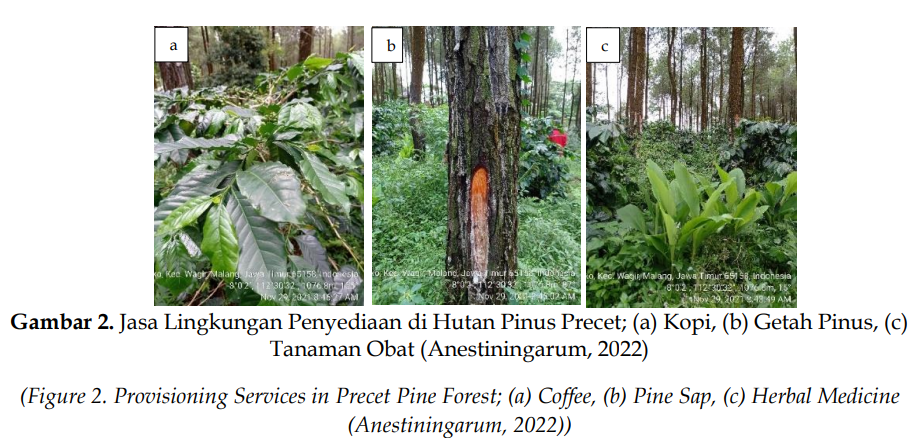Persepsi Masyarakat terhadap Jasa Lingkungan Berbasis Hutan; Studi Kasus Hutan Pinus Precet, Kabupaten Malang, Jawa Timur
DOI:
https://doi.org/10.22219/avicennia.v6i2.30037Keywords:
Wisata Alam, Jasa Lingkungan Berbasis Hutan, Konservasi HutanAbstract
Ekosistem hutan memiliki peran strategis dalam menyediakan ragam jasa lingkungan berbasis hutan bagi masyarakat luas. Keberagaman jasa lingkungan berbasis hutan diharapkan mampu meningkatkan kesejahteraan masyarakat, sehingga mampu meningkatkan dukungan masyarakat terhadap perlindungan hutan. Meskipun demikian, dukungan tersebut sangat dipengaruhi oleh persepsi mereka terhadap manfaat hutan. Untuk mengetahui ragam jaslinghut yang diterima masyarakat, penelitian ini bertujuan untuk mengetahui persepsi masyarakat lokal terhadap jaslinghut Hutan Pinus Precet, Jawa Timur. Survey kuisioner secara tatap muka dilakukan untuk menilai ragam jaslinghut dan jaslinghut yang paling dirasakan oleh masyarakat Desa Sumbersuko dan Babadan. Survey menghasilkan 131 responden. Hasil penelitian menunjukkan bahwa masyarakat penyangga Hutan Pinus Precet memiliki persepsi yang beragam terhadap jaslinghut yang mereka terima. Kemampuan hutan dalam menyediakan air bersih dan hasil hutan bukan kayu (getah pinus dan kopi) merupakan jenis jasa lingkungan berbasis hutan kategori penyedia (provisioning services) yang paling dirasakan oleh masyarakat. Masyarakat menilai bahwa Hutan Pinus Precet mampu mencegah bencana alam (longsor dan erosi), memperbaiki kualitas udara, serta kuantitas dan kualitas air (regulating and supporting services). Lebih lanjut, Hutan Pinus Precet dinilai memiliki daya tarik sebagai tempat rekreasi/refreshing/wisata (cultural services). Penelitian ini mengindikasikan bahwa Hutan Pinus Precet memiliki potensi jaslinghut yang beragam, dan temuan ini dapat digunakan sebagai dasar dalam mengembangkan strategi optimalisasi pengelolaan sumber daya hutan.
Downloads
References
Ajzen, I. (1991). The Theory of Planned Behavior. Organizational Behavior and Human Decision Processes, 50, 179–211.
Alamgir, M., Turton, S. M., Macgregor, C. J., & Pert, P. L. (2016). Ecosystem services capacity across heterogeneous forest types: understanding the interactions and suggesting pathways for sustaining multiple ecosystem services. Science of the Total Environment, 566–567, 584–595. https://doi.org/10.1016/j.scitotenv.2016.05.107
Anestiningarum. (2022). Persepsi masyarakat terhadap jasa lingkungan hutan di Kawasan Hutan Pinus Precet, Kabupaten Malang, Provinsi Jawa Timur [Sekolah Vokasi, Universitas Gadjah Mada]. https://etd.repository.ugm.ac.id/penelitian/detail/215769
Brockerhoff, E. G., Luc Barbaro, •, Castagneyrol, • Bastien, David, •, Forrester, I., Gardiner, B., Ramón González-Olabarria, J., O’, P., Lyver, B., Meurisse, N., Oxbrough, A., Taki, H., Thompson, I. D., Fons Van Der Plas, •, & Jactel, • Hervé. (2017). Forest biodiversity, ecosystem functioning and the provision of ecosystem services. Biodivers Conserv, 26, 3005–3035. https://doi.org/10.1007/s10531-017-1453-2
Chung, M. G., Dietz, T., & Liu, J. (2018). Global relationships between biodiversity and nature-based tourism in protected areas. Ecosystem Services, 34(November 2017), 11–23. https://doi.org/10.1016/j.ecoser.2018.09.004
Cruz-Garcia, G. S., Sachet, E., Blundo-Canto, G., Vanegas, M., & Quintero, M. (2017). To what extent have the links between ecosystem services and human well-being been researched in Africa, Asia, and Latin America? Ecosystem Services, 25, 201–212. https://doi.org/10.1016/j.ecoser.2017.04.005
Dang, A. N., Jackson, B. M., Benavidez, R., & Tomscha, S. A. (2021). Review of ecosystem service assessments: Pathways for policy integration in Southeast Asia. Ecosystem Services, 49, 2212–0416. https://doi.org/10.1016/j.ecoser.2021.101266
Handono Eko Prabowo, T. (2014). Developing bumdes (village-owned enterprise) for sustainable poverty alleviation model village community study in Bleberan-Gunung Kidul-Indonesia. World Applied Sciences Journal, 30(30 A), 19–26. https://doi.org/10.5829/idosi.wasj.2014.30.icmrp.4
Heerwegh, D., & Loosveldt, G. (2008). Face-to-Face versus Web Surveying in a High-Internet-Coverage Population: Differences in Response Quality. Public Opinion Quarterly, 72(5), 836–846. https://doi.org/https://doi.org/10.1093/poq/nfn045
Jiang, H., Wu, W., Wang, J., Yang, W., Gao, Y., Duan, Y., Ma, G., Wu, C., & Shao, J. (2021). Mapping global value of terrestrial ecosystem services by countries. Ecosystem Services, 52. https://doi.org/10.1016/j.ecoser.2021.101361
Kim, Y. S., Latifah, S., Afifi, M., Mulligan, M., Burk, S., Fisher, L., Siwicka, E., Remoundou, K., Christie, M., Masek Lopez, S., & Jenness, J. (2018). Managing forests for global and local ecosystem services: A case study of carbon, water and livelihoods from eastern Indonesia. Ecosystem Services, 31, 153–168. https://doi.org/10.1016/J.ECOSER.2018.03.018
Lhoest, S., Dufrêne, M., Vermeulen, C., Oszwald, J., Doucet, J. L., & Fayolle, A. (2019). Perceptions of ecosystem services provided by tropical forests to local populations in Cameroon. Ecosystem Services, 38. https://doi.org/10.1016/j.ecoser.2019.100956
Marhaento, H., Booij, M. J., & Hoekstra, A. Y. (2018). Hydrological response to future land-use change and climate change in a tropical catchment. Hydrological Sciences Journal, 63(9), 1368–1385. https://doi.org/10.1080/02626667.2018.1511054
Maryudi, A., & Krott, M. (2012). Poverty Alleviation Efforts through a Community Forestry Program in Java, Indonesia. Journal of Sustainable Development, 5(2), 43–53. https://doi.org/10.5539/jsd.v5n2p43
Muhamad, D., Okubo, S., Harashina, K., Gunawan, B., & Takeuchi, K. (2014). Living close to forests enhances people’s perception of ecosystem services in a forest-agricultural landscape of West Java, Indonesia. Ecosystem Services, 8, 197–206. https://doi.org/10.1016/j.ecoser.2014.04.003
Nugroho, P., Marsono, D., Sudira, P., & Suryatmojo, H. (2013). Impact of Land-use Changes on Water Balance. Procedia Environmental Sciences, 17, 256–262. https://doi.org/10.1016/j.proenv.2013.02.036
Nugroho, P., & Numata, S. (2021). Changes in residents’ attitudes toward community-based tourism through destination development in Gunung Ciremai national park, Indonesia. Tourism Recreation Research, 46(3), 403–421. https://doi.org/10.1080/02508281.2020.1808753
Nugroho, P., & Numata, S. (2022). Resident support of community-based tourism development: Evidence from Gunung Ciremai National Park, Indonesia. Journal of Sustainable Tourism, 30(11), 2510–2525. https://doi.org/10.1080/09669582.2020.1755675
Nugroho, P., Numata, S., & Abdi Aprilianto, N. (2020). Perceived Forest-based Ecosystem Services and Attitudes Toward Forest Rehabilitation: A Case Study in the Upstream of Central Java, Indonesia. Jurnal Ilmu Kehutanan, 14(2), 185–197. https://jurnal.ugm.ac.id/jikkt
Nugroho, P., Wiyono, W., & Alhafi, A. N. (2021). Delivering Benefits from State Forest: Lesson from Partnership of Nature-Based Tourism Development in KPH Yogyakarta. Jurnal Sylva Lestari, 9(2), 239. https://doi.org/10.23960/jsl29239-251
Peluso, N. L. (1993). “Traditions” of Forest Control in Java: Implications for Social Forestry and Sustainability. Global Ecology and Biogeography Letters, 3(4/6), 138. https://doi.org/10.2307/2997766
Rakatama, A., & Pandit, R. (2020). Reviewing social forestry schemes in Indonesia: Opportunities and challenges. In Forest Policy and Economics (Vol. 111). Elsevier B.V. https://doi.org/10.1016/j.forpol.2019.102052
Sahide, M. A. K., Fisher, M. R., Supratman, S., Yusran, Y., Pratama, A. A., Maryudi, A., Runtubei, Y., Sabar, A., Verheijen, B., Wong, G. Y., & Kim, Y. S. (2020). Prophets and profits in Indonesia’s social forestry partnership schemes: Introducing a sequential power analysis. Forest Policy and Economics, 115. https://doi.org/10.1016/j.forpol.2020.102160
Setyarso, A., Djajono, A., Nugroho, B., Wulandari, C., Suwarno, E., Kartodihardjo, H., & Sardjono, M. A. (2014). Strategi Pengembangan KPH dan Perubahan Struktur Kehutanan Indonesia (Sugiharto, Ed.). Direktorat Wilayah Penglolaan dan Penyiapan Areal Pemanfaatan Kawasan Hutan, Kementerian Lingkungan Hidup dan Kehutanan.
Suryatmojo, H. (2015). Rainfall-runoff Investigation of Pine Forest Plantation in the Upstream Area of Gajah Mungkur Reservoir. Procedia Environmental Sciences, 28(SustaiN 2014), 307–314. https://doi.org/10.1016/j.proenv.2015.07.039
Suryatmojo, H., Masamitsu, F., Kosugi, K., & Mizuyama, T. (2013). Effects of Selective Logging Methods on Runoff Characteristics in Paired Small Headwater Catchment. Procedia Environmental Sciences, 17, 221–229. https://doi.org/10.1016/j.proenv.2013.02.032
Wiratno. (2018). Sepuluh Cara baru Kelola Kawasan Konservasi di Indonesia: Membangun “Organisasi Pembelajar.” In Direktorat Jenderal KSDAE Kementerian Lingkungan Hidup dan Kehutanan. Direktorat Jenderal Konservasi Sumber daya Alam dan Ekosistem. http://ksdae.menlhk.go.id/assets/publikasi/10_Cara_Baru Kelola KK.pdf
Yokota, Y., Harada, K., Rohman, Silvi, N. O., Wiyono, Tanak, M., & Inoue, M. (2014). Contributions of Company-Community Forestry Partnerships (PHBM) to the Livelihoods of Participants in Java, Indonesia: A Case Study in Madiun, East Java. Japan Agricultural Research Quarterly: JARQ, 48(3), 363–377. https://doi.org/10.6090/jarq.48.363

Downloads
Published
Issue
Section
License
Copyright (c) 2023 Anestiningarum, Prasetyo Nugroho

This work is licensed under a Creative Commons Attribution 4.0 International License.
Authors who publish with this journal agree to the following terms:
- Authors retain copyright and grant the journal right of first publication with the work simultaneously licensed under a Creative Commons Attribution License that allows others to share the work with an acknowledgement of the work's authorship and initial publication in this journal.
- Authors are able to enter into separate, additional contractual arrangements for the non-exclusive distribution of the journal's published version of the work (e.g., post it to an institutional repository or publish it in a book), with an acknowledgement of its initial publication in this journal.
- Authors are permitted and encouraged to post their work online (e.g., in institutional repositories or on their website) prior to and during the submission process, as it can lead to productive exchanges, as well as earlier and greater citation of published work (See The Effect of Open Access).










